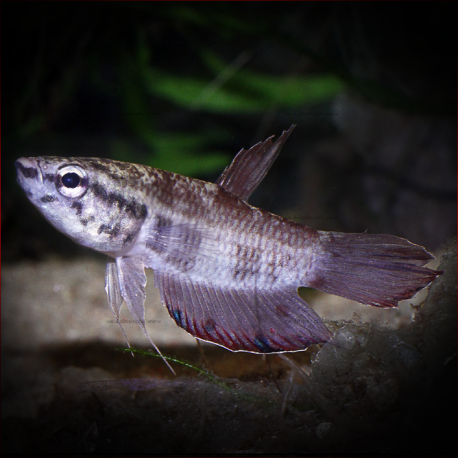More info
Datasheet
| Minimum Tank Size | 60 litres / 15.85 US gallons |
| Maximum Size | 5.0cm / 1.97inches |
| Temperature | 22°C / 71.60°F - 27°C / 80.60°F |
| Hardness | 0.00dgH / 0ppm - 5.04dgH / 90ppm |
| pH | 4.7-7.0 |
General Description
Betta Falx, a member of the Betta picta group/complex within the Betta genus, showcases distinct characteristics such as greenish-blue iridescent opercular scales and reddish bands on its fins. With almost 70 recognized species, Betta adapts to various habitats, including stagnant ditches and acidic peat swamp forests. These labyrinth fishes possess a unique respiratory organ allowing them to breathe atmospheric air to some extent.
Aquarium Setup
When setting up an aquarium for Betta Falx, a well-covered tank with dim lighting is ideal. Driftwood, roots, branches, and dried leaf litter provide shelter and mimic its natural habitat. Water should be soft with a pH range of 4.7-7.0 and a temperature of 22-27°C. Filtration must be gentle, and access to humid air above the water surface should be ensured.
Behaviour
Betta Falx is best kept alone or with peaceful species to prevent intimidation or competition. It can be maintained in pairs or groups, displaying interesting behavioral interactions, particularly when kept in a group setting.
Feeding and Diet
In the wild, Betta Falx likely preys on insects and small invertebrates. Captive specimens accept dried food but should be regularly fed small live or frozen foods like Daphnia and bloodworms to maintain optimal health. Overfeeding, leading to obesity, should be avoided.
Reproduction & Dimorphism
As a paternal mouthbrooder, Betta Falx requires a separate breeding tank with a tight-fitting cover. After a courtship ritual, the male embraces the female to release eggs and milt. Fertilized eggs are carried by the male, then transferred to the female's mouth before hatching. Males are larger with more iridescent scaling and extended fins compared to females.
Habitat and Distribution
Endemic to Sumatra, Indonesia, Betta Falx is commonly found in forest swamp streams with shallow, shaded waters abundant in organic material. They thrive in habitats with minimal dissolved minerals and a substrate of fallen leaves, branches, and submerged roots. Populations are notably located in the central province of Jambi and the region of Utara within Sumatra.

